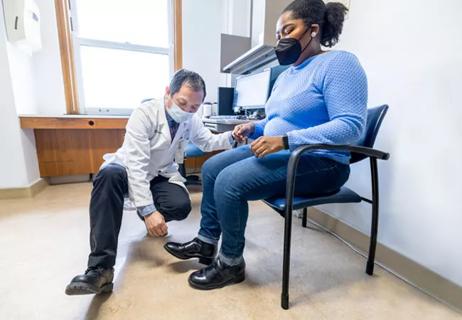Retrospective analysis assesses frequency and severity relative to a reference antibiotic

Despite long-standing warnings of the risk of myasthenia gravis (MG) exacerbations with use of fluoroquinolone and macrolide antibiotics in patients with MG, a large retrospective Cleveland Clinic study found that the frequency of such exacerbations is relatively small. In addition, there does not appear to be a statistically elevated risk of MG exacerbations following treatment with these antibiotic classes relative to amoxicillin, a reference antibiotic not associated with MG risk.
Advertisement
Cleveland Clinic is a non-profit academic medical center. Advertising on our site helps support our mission. We do not endorse non-Cleveland Clinic products or services. Policy
The study also found that two factors — female sex and recent MG-related hospitalization/emergency department (ED) visits — were most predictive of MG exacerbations among the small number of exacerbations temporally related to antibiotic administration in the analysis.
“The overall incidence of MG exacerbation was around 2% across the combined group of three fluoroquinolones or macrolides studied,” says first author S. Pinar Uysal, MD, who presented the findings at the American Academy of Neurology’s 2024 annual meeting. “This is slightly but non-significantly higher than the 1.3% incidence seen with amoxicillin. Further research is warranted to better pinpoint the risk of MG exacerbation with these antibiotic classes, but these results provide reassurance that it is not high. They also help identify in which patients we should exercise the most caution when considering use of these antibiotics.”
MG exacerbations are episodes of worsening symptoms that can be triggered by factors such as infection, stress, surgery, pregnancy or medications. Among medications, fluoroquinolone and macrolide antibiotics have been linked to MG exacerbations due to potential interference with the neuromuscular junction.
These concerns prompted the FDA to issue a black-box warning in 2011 on the risk of worsening MG symptoms with the use of fluoroquinolones. Similarly, international consensus guidance documents from a Myasthenia Gravis Foundation of America task force advised in 2016 and 2021 that fluoroquinolones and macrolides should be used with caution in patients with MG.
Advertisement
However, the evidence underlying these warnings and recommendations is based on somewhat mixed results from case reports and case series rather than prospective data or randomized clinical trials. Moreover, the presence of infections, which can independently cause MG exacerbations, makes it difficult to attribute the worsening of symptoms to the antibiotics alone.
“To bolster the evidence on this question, we conducted a retrospective analysis of the relevant Cleveland Clinic experience to investigate the association between the use of two commonly used fluoroquinolones — ciprofloxacin and levofloxacin — and one macrolide — azithromycin — and the development of MG exacerbations,” explains Dr. Uysal, a fourth-year resident in adult neurology. A second objective was to compare the frequency and severity of exacerbations associated with these antibiotics to those associated with amoxicillin, which served as a reference antibiotic from the penicillin class.
The researchers reviewed electronic medical records (EMRs) of all patients with MG who were evaluated at Cleveland Clinic’s Neuromuscular Center between 2002 and 2022. They included patients who had a confirmed diagnosis of MG based on testing or response to treatment and who also received one of the four study antibiotics (ciprofloxacin, levofloxacin, azithromycin or amoxicillin) based on EMR search. Eligible patients had to have clinical information available for at least six months before and three months after antibiotic use.
Advertisement
Antibiotic-associated MG exacerbation was defined as worsening of myasthenic symptoms or signs within 14 days of antibiotic use.
The researchers determined the strength of association between antibiotic use and MG exacerbation using the Adverse Drug Reaction (ADR) Probability Scale of Naranjo and colleagues that considered factors such as temporal relationship, alternative causes, dose-response relationship, prior exacerbations and any objective evidence of exacerbation. They analyzed the predictors of antibiotic-associated MG exacerbation using a mixed effects model that included variables such as sex, age, antibody status, disease severity, infection type and antibiotic type.
Of 1,128 MG patients identified, 365 met the inclusion criteria and collectively had 918 unique episodes of use of one of the three antibiotics of interest: azithromycin (n = 392), ciprofloxacin (n = 339) or levofloxacin (n = 187). Most episodes were for treatment of respiratory (50%) or genitourinary (25%) infections. An additional 603 episodes of amoxicillin use in 246 MG patients served as a comparator dataset.
Frequencies of MG exacerbation after antibiotic use were as follows:
The difference between amoxicillin and fluoroquinolone and macrolide antibiotics (either combined or individually) was not statistically significant.
Advertisement
Among the 17 exacerbations following use of fluoroquinolone or macrolide antibiotics, the strength of the association with the antibiotic was classified as definite in 0 cases, probable in 3 cases and possible in 14 cases. The patients who experienced exacerbations were predominantly female and predominantly had generalized MG. At the time of antibiotic use, these patients had a median age of 57 years and a median duration of MG of 35 months.
Other findings of note:
“Our findings show that the use of fluoroquinolone and macrolide antibiotics was associated with MG exacerbation in a small fraction of patients with MG and at a rate not significantly different from that with amoxicillin,” Dr. Uysal observes. “They suggest that these frequently used antibiotics can be used in MG patients whose condition is stably controlled.”
Advertisement
“At the same time, some episodes of MG exacerbation can be significant, requiring hospitalization, rescue therapy and/or a change in MG therapy,” notes the study’s senior author, Yuebing Li, MD, PhD, of Cleveland Clinic’s Neuromuscular Center. “Therefore, it is important to further narrow down the risk factors that may trigger MG exacerbations.”
“Given that this is a single-center retrospective analysis, further investigation is warranted to accurately assess the risk of MG exacerbation that may be associated with these antibiotics,” Dr. Uysal concludes.
Advertisement

An overview of associated antibodies, therapies for antibody-positive disease and the outlook for atypical forms of MG

Guidance on instructing patients, treatment selection, impact of disease course and more

Who is at risk? What tests should be ordered?

Guidance for the 5% to 20% of patients with suboptimal response or tolerability

Up to 3 days faster than waiting for urine culture results

Reassessing antibiotic dosage and type and restoring gut biome could improve survival rates

Randomized controlled trial finds no quality-of-life benefit after standard pituitary tumor surgery

Advances in genomics, spinal fluid analysis, wearable-based patient monitoring and more